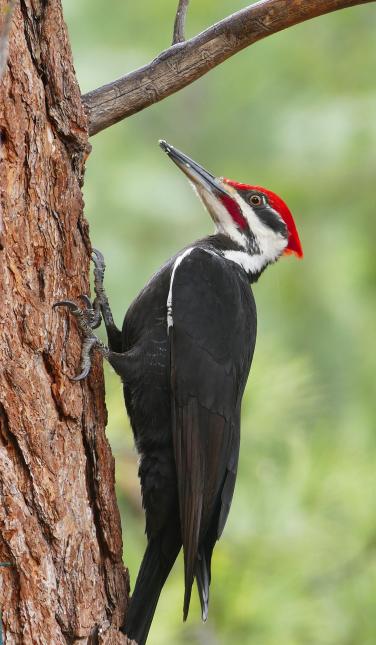Woodpeckers Unleashed: Discovering the Marvels of These Proficient Tree Mountain Climbers
Woodpeckers, with their distinct markings and rhythmic drumming resembling with wooded areas, hold a special area in the bird globe. Their specialized anatomy and adaptations enable them to browse upright surface areas with unparalleled skill. Their mastery of tree climbing is simply one element of their interesting habits. As we look into the detailed details of woodpeckers' nesting habits, feeding methods, and the ongoing conservation initiatives to protect these amazing birds, a much deeper appreciation for their place in nature unfolds.
Makeup and Adaptations
When examining the anatomy and adjustments of woodpeckers, one can observe impressive attributes that enable these birds to prosper in their specialized eco-friendly niche. In addition, woodpeckers have zygodactyl feet, with 2 toes facing onward and two encountering in reverse, providing a company hold on tree trunks while they search for food or drum for interaction.
Moreover, woodpeckers have an unique tongue framework that is long, barbed, and sticky, allowing them to draw out insects from holes in timber. This customized adjustment allows woodpeckers to manipulate a food resource that is unattainable to many various other bird species. Overall, the anatomy and adaptations of woodpeckers showcase the exceptional transformative remedies that have actually enabled these birds to thrive in their arboreal habitat.
Drumming Habits
Having checked out the composition and adjustments of woodpeckers, the emphasis now changes to recognizing their drumming actions, an unique facet of their communication and territorial screens. Drumming is an important type of communication among woodpeckers, offering numerous objectives such as developing regions, bring in friends, and signaling alarm system. Each woodpecker types has an one-of-a-kind drumming pattern that helps individuals acknowledge participants of their very own types and identify them from competitors or predators.
Woodpeckers create drumming sounds by quickly pecking on resonant surface areas such as dead trees, utility posts, or even steel objects, developing a collection of balanced beats. The strength and speed of drumming can vary based upon the purpose; as an example, a rapid drumming series may symbolize aggression in the direction straight from the source of intruders, while a slower and softer drumming pattern can suggest courtship (Woodpeckers in Florida). In addition, woodpeckers may adjust the regularity and duration of their drumming to share particular messages efficiently
Nesting Practices
Checking out the nesting practices of woodpeckers discloses remarkable insights into their reproductive actions and environment choices. Woodpeckers are known for their unique nesting choices, often excavating cavities in trees to produce protected spaces for raising their young. These cavities serve not just as a nesting site yet likewise as a protected haven from killers and severe climate.
Woodpeckers display a high level of integrity to their nesting websites, often returning to the exact same location year after year. This actions highlights the importance of ideal habitat accessibility for their reproductive success. The choice of a nesting site is important for woodpeckers, with variables such as tree species, height, and decay phase playing considerable roles in their decision-making procedure.
Surprisingly, some woodpecker types are known to excavate multiple dental caries within their area, giving themselves with different nesting alternatives. This approach may serve as a form of insurance versus possible threats or disruptions to their primary nesting site.

Feeding Strategies
One of the most distinct feeding behaviors of woodpeckers is drumming, which involves rapid pecking on trees to reveal insects under the this hyperlink bark. Woodpeckers are likewise recognized to dig deep into cavities in trees to accessibility concealed insect larvae or sap. Some types, like the acorn woodpecker, shop nuts in particularly created holes called granaries.
Conservation Efforts
Among the intricate feeding strategies showed by woodpeckers, the preservation initiatives targeted at safeguarding these remarkable birds play a critical duty in preserving their habitats and populations. Woodpeckers face various threats to their survival, consisting of environment loss due to logging, climate modification modifying their environments, and collisions with synthetic frameworks such as buildings and vehicles more - Woodpeckers in Florida. Conservationists are proactively working to resolve these challenges and guarantee the lasting well-being of woodpecker species

Education and learning and public awareness campaigns are additionally important components of woodpecker preservation initiatives. By elevating awareness regarding the importance of these birds in preserving healthy forest ecosystems, guardians can amass support for environment preservation efforts and advertise responsible land monitoring practices. Via joint initiatives in between scientists, policymakers, and regional communities, we can collaborate to safeguard a future where woodpeckers flourish in their all-natural habitats.
Verdict

Comments on “Woodpeckers in Florida: Natural History, Ecology, and Conservation”